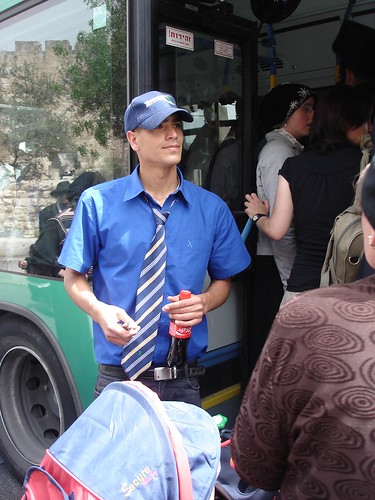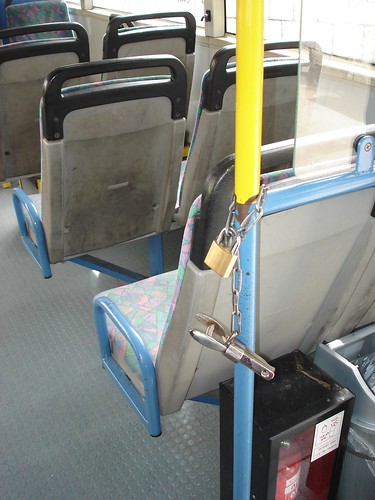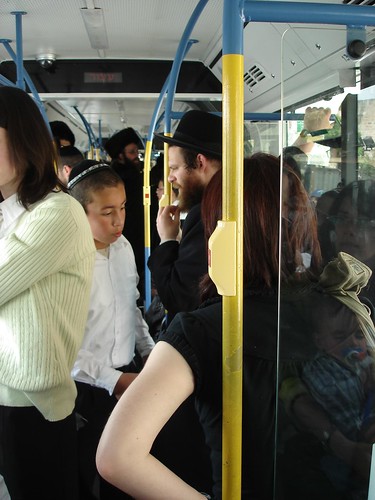Forced Segregation on Jerusalem’s Buses
Last Pessah, I went on two tours in the City of David and enjoyed them very much. (Pictures and explanations available here.) The first tour ended after dark. I walked back up to the main road just outside the Old City, caught a bus downtown and went home.
I returned to the City of David the following morning to take another tour... and was not at all prepared for what happened afterwards.
The buses ran almost continuously in order to accommodate the huge crowds, as well as the fact that private vehicles are not allowed in or around the Old City during the intermediate days of Pessah and Sukkot. As I waited, together with a woman tourist whom I had volunteered to guide on part of her journey to the northern part of the city, several buses pulled up. When the doors opened, uniformed Egged employees stepped outside, some with bullhorns, directing men to board from the front and women from the back.
During the year, these particular bus lines do not have separate seating, despite the vigorous efforts of some elements to obtain it. When I asked the guard at the door who had ordered the current separation, he replied, “The modesty patrol.” I said, “Since when does the Egged bus company take orders from the modesty patrol?” “Since always,” he answered. “Not true,” I said. “I’ve been living here for a long time, and this is the first I’ve seen of it.”
I forgot to ask him why separate seating had not been enforced the evening before, but I think I know the answer: money. I imagine that it costs quite a bit to employ the guards at night as well as during the day. I find that ironic, since according to Jewish law, the rules about modest behavior between men and women become more stringent at night.
Here, a Haredi woman (wearing a black and white blouse, sitting near the open door with her back to the window) is scolded for refusing to move to the back of the bus. As the bus pulls away, several people at the bus stop can be heard expressing their support for her.
On the sex-segregated bus lines, a hole-puncher is placed at the rear door so that the women passengers can punch their own ride cards. But what happens if a woman should need to buy something, such as a transfer ticket, directly from the driver at the front of the bus, where only men may board? Apparently, nothing. The woman whom I guided part of the way to her destination needed a transfer ticket because she intended to take more than one bus, but was prevented from buying one because she couldn’t reach the driver. So she rode for free—not because she wanted to, but because she was given no choice.
The hole-puncher for women at the rear of the bus. Women who need to buy a ride card or a transfer ticket up front, from the driver, are apparently out of luck.
As one might imagine, the segregation is not enforced fairly. As I watched, an elderly man made his way to the rear of the bus and stood in the doorway, in what was supposed to be the section reserved for women. (To me, this is disturbingly familiar. If I remember the race-segregation rules on buses in the southern United States of half a century ago correctly, African-American people had to sit in the back, but had to give up even those seats to white passengers if the bus became crowded.)
Another example of a “male invasion” of the women’s section. (Imagine what would happen if the women’s section were to be more crowded and the women were forced to stand in the men’s section to accommodate the overflow.)
Peggy Cidor of the Jerusalem Post writes about the latest on the issue here. Although the newspaper chose to give her article the title “The Road to Purity,” as I have said many times, I believe that this issue has nothing to do with purity or modesty, and everything to do with power and control.
Here are the rest of the photos I took at the bus stop that day. Here is another video that shows the segregation more clearly. I have written about this issue on this blog in the past, here and here.




No comments:
Post a Comment
Comments are moderated. If you're a spammer, don't waste your keystrokes. If you're a real, honest-to-goodness commenter, welcome!